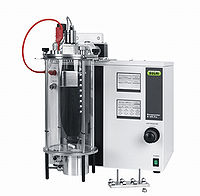Encapsulators
Jump to navigation
Jump to search
Encapsulators use the same unique technology, which is based on the principle that a laminar flowing liquid jet breaks up into equally sized droplets by superimposed vibration. The selectable vibration frequency determines the quantity of droplets produced; for example, 1'000 droplets are generated per second at 1'000 Hz. The droplet chain is electrostatically charged causing the droplets to repel each other, thus eliminating coalescence. The droplets fall into a hardening solution where the beads are polymerized quickly or in a cooling chamber where the beads solidify.
Areas of Applications
Pharmaceutical Industry
- Encapsulation of active ingredients (e.g. poorly soluble drugs in polymeric microspheres)
- Drug delivery systems with controlled drug release (e. g. biodegradable polylactic-acid beads)
- Protection of active ingredients (e.g. reducing interaction with other agents during storage)
- Coating of particles with new functions (e.g. modulated release)
- Taste masking of bitter agents in capsules produced with concentric nozzles
- Encapsulation of vaccines for wild animals
- Sterile encapsulation of mammalian cells and thereby protection of cells from the immune system for cell transplantation (e.g. treatment of *gene deficiency)
- Protection of cells from shear stress in stirred reactors
- Capsules as micro systems for cell retention with high cell density
- Immobilization of microbes and enzymes for biotransformation
Food Industry
- Encapsulation of probiotic ingredients (e.g. lactic acid bacteria)
- Stabilization and protection of neutraceuticals (e.g. vitamins, oils)
- Optical enhancement of foodstuff
- Molecular kitchen applications
Video
